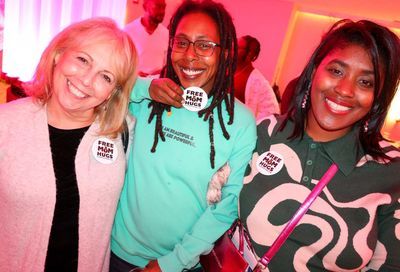News Analysis: The DOMA Decision Is A Narrow One — Which Could Be Key at the Supreme Court
The opinion from the U.S. Court of Appeals for the First Circuit on May 31 striking down Section 3 of the Defense of Marriage Act in Gill v. Office of Personnel Management was not a broad ruling striking down the federal definition of marriage on a variety of grounds — as the trial-court judge had done when he decided the case initially in 2010.
While giving credence to several of the factors — from sexual orientation discrimination to federalism — that each independently were considered decisive by U.S. District Court Judge Joseph Tauro, the appellate opinion, written by Judge Michael Boudin, was a far more narrow ruling that decided the case on the sole grounds that Congress gave no rational basis for enacting the law.
Boudin — appointed to the court by President George H. W. Bush — specifically did not adopt the position urged by the Justice Department that laws that classify people based on sexual orientation should be subjected to heightened scrutiny when courts consider their constitutionality.
 The Gill decision, in part, turned upon the Supreme Court’s 1996 decision in Romer v. Evans, a case in which Justice Anthony Kennedy, joined by five of his colleagues, held that — even under the “rational basis,” or the lowest level of, scrutiny — Colorado voters could not enact a law that removed gay, lesbian and bisexual people from the political process by prohibiting any jurisdiction in the state from passing ordinances protecting LGB people from discrimination.
The Gill decision, in part, turned upon the Supreme Court’s 1996 decision in Romer v. Evans, a case in which Justice Anthony Kennedy, joined by five of his colleagues, held that — even under the “rational basis,” or the lowest level of, scrutiny — Colorado voters could not enact a law that removed gay, lesbian and bisexual people from the political process by prohibiting any jurisdiction in the state from passing ordinances protecting LGB people from discrimination.
After reviewing the four main reasons offered in defense of the law, Boudin wrote, “We conclude … that the rationales offered do not provide adequate support for section 3 of DOMA.”
It is not unusual for an appellate opinion to be narrower than the trial-court decision that it is reviewing, and it already has happened in another closely watched LGBT equality case this year.
In August 2010, California’s Proposition 8 was declared unconstitutional by U.S. District Court Judge Vaughn Walker on multiple independent grounds and included a conclusion that “gays and lesbians are the type of minority strict scrutiny was designed to protect.” After an extensive appellate process, the U.S. Court of Appeals for the Ninth Circuit ruled earlier this year that the constitutional amendment was invalid under the narrow grounds employed by the Supreme Court in Romer.
Romer, which was a landmark case when decided, has taken a backseat over the past decade to another Supreme Court case, Lawrence v. Texas. That 2003 case struck down sodomy laws and is seen by some, like Lambda Legal executive director Kevin Cathcart, as the likely turning point for advocates of LGBT equality.
Although it certainlyis true that Lawrence changed the conversation about LGB equality forever by eliminating the criminalization of the very behavior that, in many ways, defines gay people, it also is true that it is a sweeping decision that lower courts (with some notable exceptions like the Massachusetts Supreme Judicial Court in its 2003 marriage equality-creating opinion (pdf)) have been reluctant to apply broadly to other “gay rights” cases.
Enter Romer.
After analyzing the Colorado amendment’s potential impact, Kennedy wrote, “We must conclude that Amendment 2 classifies homosexuals not to further a proper legislative end but to make them unequal to everyone else. This Colorado cannot do. A State cannot so deem a class of persons a stranger to its laws.”
With the cultural legacy and import of Lawrence firmly in place, Romer can be set free to do the hard work of beginning the process of truly achieving legal equality for LGBT people. Before one can advance equality, one must first be able to remove the roadblocks established that inhibit that progress. With its focus on laws aimed at impeding gay, lesbian and bisexual people, Romer is able to take on anti-LGBT laws.
At some point, if LGBT equality is to be achieved in the law, the call of LGBT advocates and the Justice Department that the courts should declare that sexual orientation and gender identity classifications are to be subjected to heightened scrutiny will need to be heeded.
Once the big roadblocks have been moved out of the way — California’s decision to deny marriage equality by constitutional amendment after the state’s high court had held that it was required, for example, or the unprecedented congressional attempt with DOMA to define “marriage” in all federal respects across the board — then some form of heightened court scrutiny will be needed to advance LGBT legal equality across the country with uniformity.
That broad action and sweeping decision, however, is not necessary for these first steps. As with Romerand Lawrence, there are several laws, regulations and policies that explicitly and forthrightly aim at treating LGBT people worse when compared to non-LGBT people. Courts are able to strike down these laws — albeit, at times, creatively — by applying the reasoning of Romer.
If that was all that such a decision did, then it mightn’t be an advisable course because it does slow the progress toward legal equality for LGBT people. As Boudin’s opinion makes clear, however, Romer and the cases that preceded it (primarily, U.S. Department of Agriculture v. Moreno and City of Cleburne v. Cleburne Living Center) could do more. They allow a conservative judge — even one who might not yet think a state should be required to allow same-sex couples to marry — nonetheless to strike down a law like Section 3 of DOMA.
Boudin writes, for example, “[W]e do not rely upon the charge that DOMA’s hidden but dominant purpose was hostility to homosexuality.” Of “marriage as traditionally defined over centuries of Western civilization,” he even goes so far as to declare that “[p]reserving this institution is not the same as ‘mere moral disapproval of an excluded group'” — the language used by Justice Sandra Day O’Connor in her opinion in Lawrence striking down sodomy laws.
Although Boudin’s reasoning may not be the language an LGBT activist wants to read, it is the type of language that could calm a judge concerned about moving too quickly on an issue that remains largely unresolved in public debate in most parts of the country. The Gill case is not about marriage equality itself, and Boudin’s opinion makes that clear to all.
The lawyer who argued Romer before the Supreme Court, Jean Dubofsky, discussed how this strategy was at play even when Romer was argued, saying in a New York Times article in 2005, “In this particular case if you wanted to get the U.S. Supreme Court turned around on gay rights issues, you didn’t have to win every gay rights case floating around out there.”
Boudin’s opinion is not the progressive activists’ ideal. It would not win every LGBT equality case floating around out there. What it is, though, may be more important.
The First Circuit’s Gill opinion is a roadmap for Justice Kennedy. It even may serve as one for Chief Justice John Roberts, who, as a lawyer in private practice at the time, spent six hours helping Dubofsky to prepare for the Supreme Court oral arguments in Romer — by pretending to be a conservative justice hearing the case.
Support Metro Weekly’s Journalism
These are challenging times for news organizations. And yet it’s crucial we stay active and provide vital resources and information to both our local readers and the world. So won’t you please take a moment and consider supporting Metro Weekly with a membership? For as little as $5 a month, you can help ensure Metro Weekly magazine and MetroWeekly.com remain free, viable resources as we provide the best, most diverse, culturally-resonant LGBTQ coverage in both the D.C. region and around the world. Memberships come with exclusive perks and discounts, your own personal digital delivery of each week’s magazine (and an archive), access to our Member's Lounge when it launches this fall, and exclusive members-only items like Metro Weekly Membership Mugs and Tote Bags! Check out all our membership levels here and please join us today!





















